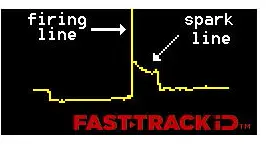TECHNICAL REFERENCE
Released by Snap-on Diagnostics
September 2024
Keith Wray
Snap-on® Diagnostic National Trainer
My career has spanned through the four major types of automotive ignition systems:
• Conventional breaker-point (mechanical) ignitions
• High energy (electronic) ignitions - HEI
• Distributor-less (waste spark) ignition

On a conventional ignition system, points were used to turn the current on and off. Today, COP systems utilize cam and crank sensors to signal a module to turn the current on and off.
On these modern systems the powertrain control module (PCM) can set codes for engine misfires. P0301, P0302, P0303, P0304, P0305, P0306, P0307 and P0308 all represent misfires on cylinders one through eight. P0300 is a random misfire from cylinder to cylinder, fuel volume/pressure issues or vacuum leaks might cause a random misfire, for example. These misfire codes can point you in the right direction then pinpoint testing would be the next step.
Below shows the optional COP 11 adapter that allows the ZEUS® to test secondary ignition.

When we go to guided component tests and take a class on secondary ignition, we learn about how to use the firing section of the scope pattern to spot ignition misfires.
The firing section consists of the firing line and the spark line. The firing line is measured in KV and is how much voltage to jump the plug gap. The spark line shows how much voltage it takes to maintain the spark and displays the burn time.

The spark line and burn time are affected by the gap and conditions in the cylinder like fuel mix or mechanical issues.
High firing line voltages indicate high resistance or lean air/fuel mix. Low lines could be a rich mix or low compression.
Another popular way to diagnose ignition issues is with a low current ramp test. By simply clamping the low amp probe around the primary power wire or fusible link, you will get a clear picture or current/amperage flowing through the circuit.

Coils may limit the current and have a flat top. Others have a sharp peak.

If the coil waveform has a sharp rise at the beginning of the ramp, suspect a shorted coil, as seen below.

Ignition systems have been around since the beginning of internal combustion engines. Since their inception, ignition systems have been a leading cause of misfires and check engine lights. The key takeaway for this common issue is to be able to quickly and accurately diagnose those ignition problems.
Click here for more on this topic, and for so much more, visit Snap-on’s technical article pages.